After the United States declared war on Germany in 1917, industry resources on weaponry and technology increased considerably.
It prompted President Woodrow Wilson to establish the Committee on Public Information, managing its official propaganda and advertising efforts.
The Creel Committee was named for its director, George Creel, who recognized the importance of the press in molding public opinion.
Creel appointed Charles Dana Gibson, the country’s most well-known and well-paid commercial illustrator, to head the Division of Pictorial Publicity.
As such, Gibson oversaw the work of over 300 illustrators who became known as The Vigilantes for their contributions to the war cause.
Edward Penfield, James Montgomery Flagg, Joseph Christian Leyendecker, Howard Chandler ChristyHoward Chandler Christy, Herbert Paus, C.B. Falls, E.H. Blashfield, Joseph Pennell, Joseph Leyendecker, Jessie Willcox Smith, and L.N. Britton were among the group’s renowned commercial artists.
Posters were essential to the United States’ war efforts during World War 1.
Their unrivaled capacity to communicate swiftly enabled the government and support groups to mobilize the home front by convincing and enlightening the population on public policy issues.
War efforts also used posters to generate funds, attract soldiers, increase production, increase public support, incite anger at enemy crimes, and promote assistance for various relief activities.
In less than two years, the United States generated over 2,500 posters and approximately 20 million posters—nearly one for every four citizens.
Their historical significance and enduring popularity originate from their ability to express the spirit of patriotism and a sense of duty in spectacular visual metaphors in the early twentieth century.
What type of propaganda was used in W.W. 1?
Content
The government propelled propaganda in postcards, posters, and trade cards that flourished during World War 1 due to developments in print technology that began in the 19th century.
What effect did propaganda have on W.W. 1?
The governments of the conflicting countries used propaganda like any other war, with the truth of suffering. Propaganda ensured that the citizens learned only what the governments wanted them to know.
Who made propaganda posters in W.W. 1?
Some of the most famous W.W. 1 propaganda posters were designed and created by James Montgomery Flagg, a prominent U.S. artist. He designed 46 posters for the government. The most famous of his posters was the “I Want You for U.S. Army.”
World War 1 Poster Purpose, Themes, and Series
World War 1 saw many primary kinds of poster series.
The themes included recruitment posters, financial posters, national symbols, posters dealing with food issues, war bonds and funds posters, relief posters, and organizational posters.
Recruitment Posters

Enlistment in the Marines, U.S Army, Air Force, Navy, Tank Corps, American Field Service, various municipal and state regiments, and the National Guard was encouraged via recruitment posters.
Many recruitment posters also urged males to exercise civic duty and join the military. During the prior war years, the United Kingdom produced many recruitment posters.
Before May 1916, the British army was entirely voluntary when conscription was implemented.
Attractive posters were an essential strategy in getting as many men to enroll as possible.
Four pristinely preserved and rarely seen posters, printed in Jamaica and sent to the men of the Bahamas, demonstrate how this conflict-affected many places of the world outside the actual battlegrounds.
Financial Posters
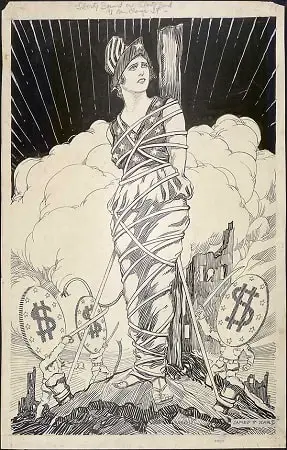
Likewise, financial support posters urged Americans to purchase the first four Liberty Loans and the Victory Liberty Loan. It also encouraged various war bonds and war savings stamps.
Recruitment was not an urgent requirement in countries where conscription was the norm (France, Germany, Austria), and most advertisements were targeted at raising money to finance the war.
Those who did not join were requested to purchase bonds or make war loan payments. Many finance posters make use of numismatic imagery to make their point.
Coins can become projectiles, crush opponents, or serve as shields in the battle effort.
Patriotic Posters
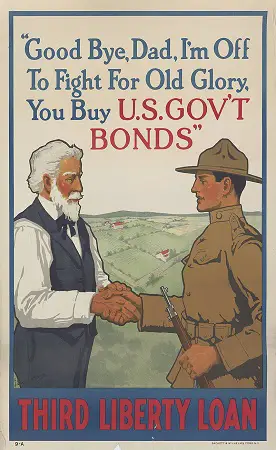
Patriotic posters, also produced by the government and various state civilian organizations, likewise encouraged farmers, workers, women, and children to participate in war work and support their country’s war effort.
Among the messages encouraging general patriotism are warnings to be on the lookout for spies, avoid rumors, and avoid “war talk.”
Conservation posters similarly, urged civilians to preserve food, fuel, and other supplies for the war effort.
Foreign Aid Posters
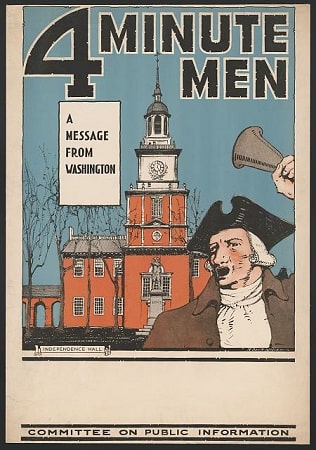
On relief posters, aid was asked for other countries, children, families, and troops. Organizational posters for the Red Cross, the Y.W.C.A., the Y.M.C.A., and other organizations’ varied aid and membership activities.
The Women’s Land Army began as a British civilian group to increase agricultural output by farming the fields for farmers serving in the military.
Organizational Posters
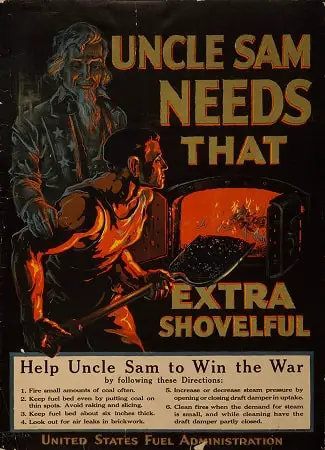
In the United States, a Women’s Land Army was also formed. In like manner, foreign posters encouraged Americans to join the Allies in their fight against aggressors in Europe, Africa, and Asia.
Furthermore, throughout Europe during the war, food shortages were common. Before the U.S. entered the war, American aid organizations transported food to other countries.
On the home front, it was perceived that Americans would change their eating patterns so that food could be saved and delivered abroad.
Americans were urged to consume less meat and grains and more corn and fish.
Americans were also encouraged to grow victory gardens and preserve fruits and vegetables. In the United Kingdom, eggs were gathered for the injured to aid in their recuperation.
The Comité National de Prévoyance et d’Economies in France sponsored a poster competition for pupils to design conservation posters.
National Symbol Posters
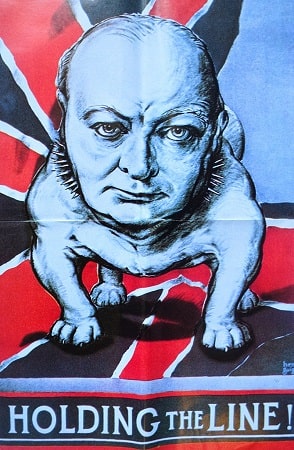
Many of the posters use symbolism to make their point. Uncle Sam appears regularly as a symbol for the United States on posters.
On other posters, the United Kingdom is represented by John Bull and Britannia, while Marianne represents France.
The Allies frequently depicted Germany as a caricature known as a “Hun,” commonly represented wearing a pickelhaube (spiked helmet), often covered in blood.
Whistler’s mother from the painting “Arrangement in Grey and Black” on a single Canadian poster represents all mothers. Men are recruited to enter the Irish Canadian Rangers and “fight for her.”
Brief History of Poster Art in America (The Country that Produced the Most Propaganda Posters during WW 1)

Posters have numerous purposes, including art, advertising, and education. Poster art also acts as cultural commentary by reflecting its creator’s political and social tendencies.
Posters were also widely used as a communication medium before World War 1.
Alois Senefelder invented lithography in 1796, printing multiple copies of a document or image on a limestone plate.
Soon, lithographers began producing colored prints and posters on a succession of limestone plates.
Jules Cheret’s three-stone lithography process, which generated brilliant colors and astonishing textures, elevated poster creation to an art form in the 1870s.
Cheret’s designs blended words and images with stunning fonts and brilliant colors to create a dramatic innovation: the lithographic poster. Several notable artists, Henri de Toulouse-Lautrec, created poster art during this period.
Toulouse-debut Lautrec’s poster, Moulin Rouge, raised posters to the realm of great art in 1891.
Although the poster played an important part in communication throughout WW2, it was overshadowed by other forms of media, primarily radio and print.
Poster production began to fall in the 1950s as television became a new competition. The poster’s role and appearance have evolved continuously over the last century to satisfy society’s evolving needs.
Although the poster’s role in communication is less important than 100 years ago, it still can affect opinion and define our culture.
Famous Propaganda Posters of World War 1 and their Sentiments towards People
I Want You for U.S. Army
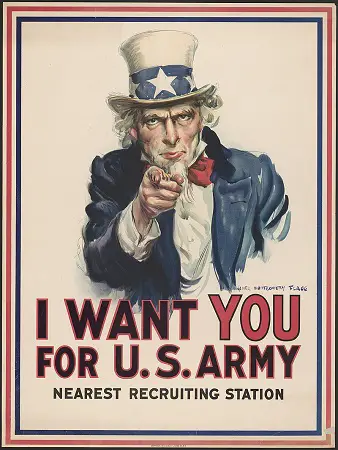
James Montgomery Flagg’s serious image of Uncle Sam pointing at the viewer above the words “I Want You for U.S. Army” is one of the most famous American images ever created.
The illustrators employed advertising methods and visual design to engage and provoke emotional responses from passers-by.
It is, without question, the most well-known World War 1 poster.
The artist was portrayed as Uncle Sam. The poster was first printed in 1916; by 1918, over four million copies had been sold.
Flagg was a member of Charles Gibson’s Committee on Pictorial Publicity, part of the federal government’s Committee on Public Information, which George Creel chaired.
Britons. Join Your Country’s Army!
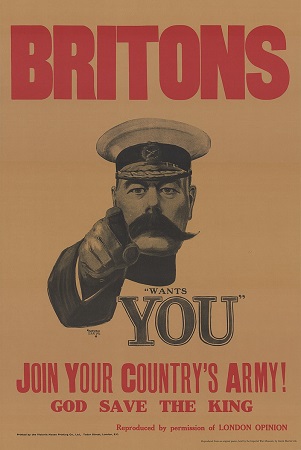
This is possibly the most iconic poster from the First World War. It depicts Field Marshal Lord Kitchener urging people to join the British Army.
First created in 1914, the poster gained greater iconic importance since the war when it was not extensively distributed outside of the London area.
However, its stunning visual appeal was adopted by other artists, especially those in the United States, where the image of Kitchener was substituted with Uncle Sam.
Columbia Calls
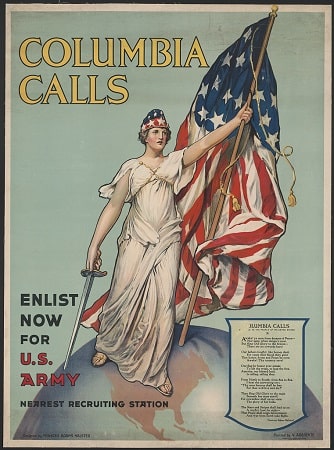
The poster depicts Columbia holding a flag and a sword while standing in North America on top of a globe in print. There is the text of a poem by Halsted in the lower right corner.
The poster’s contributors include Halsted Vincent as the artist and Frances Adams as the designer.
Frances Adams Halsted penned her poem, Columbia Calls, in 1916, convinced that war with Germany was unavoidable.
Halsted submitted her poetry and the accompanying picture design to the United States War Department after America declared war on April 6, 1917.
After three months or so, the New York Times announced plans to print 500,000 posters with the proceeds to establish a shelter for orphaned children of American soldiers and sailors.
Vincent Aderente, the painter who executed Halsted’s design, moved from Italy when he was six.
He studied with and trained at the Art Students League in New York City and worked as an assistant to muralist Edwin Howland Blashfield.
Women of Britain say, ‘Go!’
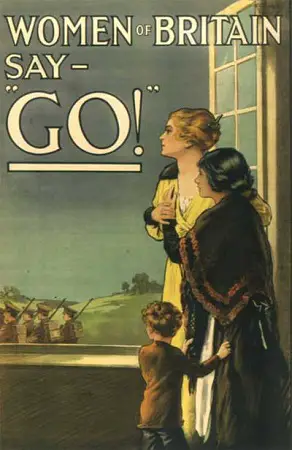
This billboard displays the use of commercial advertising strategies in the recruiting effort. It appeals to the British female population to persuade more men to join the army.
The poster shows women and children in need of protection.
On the other hand, the First World War significantly boosted the number of women in paid work and the variety of jobs they performed.
Wake up, America!
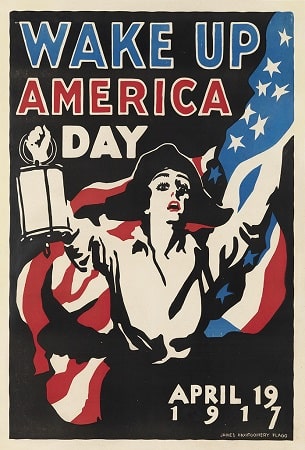
On April 6, 1917, the United States entered World War 1 after two and a half years of neutrality.
In this poster, displayed on “Wake Up, America” Day in New York City just thirteen days later on April 19, James Montgomery Flagg, who created some of the war’s most unforgettable imagery, rang the alarm for all residents.
Flagg’s Columbia model was actress Mary Arthur, representing America and Liberty.
She is portrayed sleeping while wearing patriotic stars, stripes, and a Phrygian cap. These had been used as a symbol of freedom since Roman times.
Sinister storm clouds gather in the backdrop as she falls asleep against a fluted column, another pictorial reference to Western classical antiquity and civilization.
Women Urgently Wanted For The W.A.A.C.

In December 1916, the Women’s Army Auxiliary Corps (WAAC) was formed. Women who joined the Corps performed various non-combatant duties in France.
This was aimed at allocating more men for front-line service.
On March 31, 1917, the first group of 14 women arrived on the Western Front. Nine thousand women eventually served with the regiment in France.
Remember Scarborough
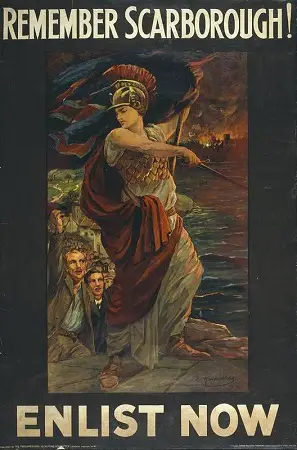
The German First High Seas Fleet Scouting Group bombed the North Sea ports of Hartlepool, West Hartlepool, Whitby, and Scarborough on December 16, 1914.
137 people were killed, and 592 were injured. The ad used the incident to encourage people to enlist, but the British public and press were equally upset at the Royal Navy for failing to protect the towns.
Conclusion
Posters helped sell the war. These posters encouraged you to enroll, raise the flag, and fight for your nation.
They made you fear an enemy or manufactured a fear you didn’t realize you had in other circumstances.
Nations had to persuade their citizens that this war was just, and we had to join rather than sit back and watch.
Although propaganda posters existed before 1917, World War 1 posters’ coordination and mass dissemination distinguished them from previous printings.
Despite the passage of 100 years and many wars and disillusionment with them, these posters continue to pique one’s interest.
The lines between good and evil are drawn. It’s difficult to ignore the pain. The signs also instruct people on how to assist the war efforts.
